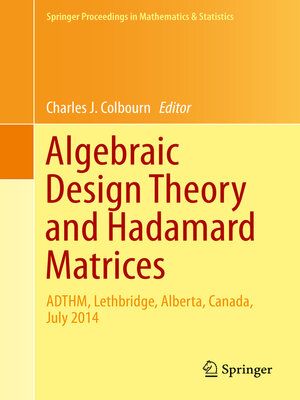Algebraic Design Theory and Hadamard Matrices
ebook ∣ ADTHM, Lethbridge, Alberta, Canada, July 2014 · Springer Proceedings in Mathematics & Statistics
By Charles J. Colbourn

Sign up to save your library
With an OverDrive account, you can save your favorite libraries for at-a-glance information about availability. Find out more about OverDrive accounts.
Find this title in Libby, the library reading app by OverDrive.



Search for a digital library with this title
Title found at these libraries:
| Library Name | Distance |
|---|---|
| Loading... |
This volume develops the depth and breadth of the mathematics underlying the construction and analysis of Hadamard matrices, and their use in the construction of combinatorial designs. At the same time, it pursues current research in their numerous applications in security and cryptography, quantum information, and communications. Bridges among diverse mathematical threads and extensive applications make this an invaluable source for understanding both the current state of the art and future directions.
The existence of Hadamard matrices remains one of the most challenging open questions in combinatorics. Substantial progress on their existence has resulted from advances in algebraic design theory using deep connections with linear algebra, abstract algebra, finite geometry, number theory, and combinatorics. Hadamard matrices arise in a very diverse set of applications. Starting with applications in experimental design theory and the theory of error-correcting codes, they have found unexpected and important applications in cryptography, quantum information theory, communications, and networking.
The existence of Hadamard matrices remains one of the most challenging open questions in combinatorics. Substantial progress on their existence has resulted from advances in algebraic design theory using deep connections with linear algebra, abstract algebra, finite geometry, number theory, and combinatorics. Hadamard matrices arise in a very diverse set of applications. Starting with applications in experimental design theory and the theory of error-correcting codes, they have found unexpected and important applications in cryptography, quantum information theory, communications, and networking.







